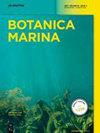巴利阿里群岛马略卡岛南部海岸以大型藻类为主的泥质海底的生物学研究
IF 1.4
4区 生物学
Q2 MARINE & FRESHWATER BIOLOGY
引用次数: 0
摘要
摘要:本文对马略卡岛南部(地中海西部巴利阿里群岛)以大型藻类为主的碎屑底进行了生物学研究,包括对该地区藻类群落的定量描述,以及它们的水深和地理分布。这里展示的结果是基于2012年7月和2014年9月进行的两次海洋学活动收集的数据,使用的是詹宁斯梁拖网。分层群平均聚集聚类,伴随着SIMPROF测试,允许识别七个不同的大藻群落,其中两个是第一次在这里描述:长关节隐藻场和Maërl不确定的rhodoliths床。深度和rhodolith丰度是驱动这些群落分布的两个主要特征。通过SIMPER检验,我们发现7个物种贡献了样品间70%的相似性,其中不确定的rhodoliths(23.6%)和包覆的肉质红藻Agissea inamoena(15.6%)是最重要的。结果表明,样品选择和定量过程所采用的方法比用于表征碎屑底大型藻类群落的其他方法非常有效和快速,这表明本研究可以作为类似研究和未来管理和保护行动的基线。本文章由计算机程序翻译,如有差异,请以英文原文为准。
Bionomic study of the detritic bottoms dominated by macroalgae from the southern coast of Mallorca (Balearic Islands)
Abstract This bionomic study of the detritic bottoms dominated by macroalgae from the south of Mallorca (Balearic Islands, Western Mediterranean) includes a quantitative description of the algal communities found in the area, as well as their bathymetric and geographical distribution. The results presented here are based on data collected in two oceanographic campaigns conducted in July 2012 and September 2014, using a Jennings beam trawl. A hierarchical group average agglomerative clustering, accompanied by the SIMPROF test, allowed the identification of seven different macroalgal communities, of which two are described here for the first time: the Cryptonemia longiarticulata fields and the Maërl beds of indeterminate rhodoliths. Depth and rhodolith abundance were the two main features driving the distribution of these communities. We found that seven species contributed 70% of the similarity between samples (SIMPER test), with the indeterminate species of rhodoliths (23.6%) and the encrusting fleshy red alga, Agissea inamoena (15.6%) being the most important. The methodology used for the sample selection and quantification processes turned out to be very efficient and faster than other methods used for the characterization of macroalgal communities from detritic bottoms, suggesting that this study could serve as a baseline for similar studies and for future management and conservation actions.
求助全文
通过发布文献求助,成功后即可免费获取论文全文。
去求助
来源期刊

Botanica Marina
生物-海洋与淡水生物学
CiteScore
4.10
自引率
4.50%
发文量
43
期刊介绍:
Botanica Marina publishes high-quality contributions from all of the disciplines of marine botany at all levels of biological organisation from subcellular to ecosystem: chemistry and applications, genomics, physiology and ecology, phylogeny and biogeography. Research involving global or interdisciplinary interest is especially welcome. Applied science papers are appreciated, particularly when they illustrate the application of emerging conceptual issues or promote developing technologies. The journal invites state-of-the art reviews dealing with recent developments in marine botany.
 求助内容:
求助内容: 应助结果提醒方式:
应助结果提醒方式:


